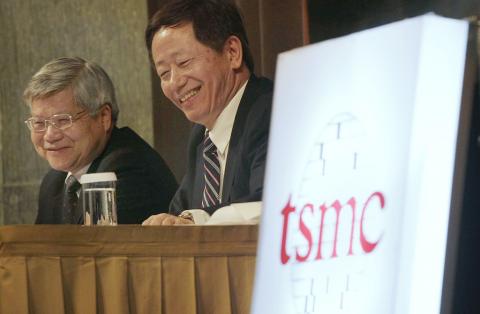Taiwan Semiconductor Manufacturing Co (TSMC, 台積電) yesterday forecast better-than-expected sequential growth of 22 percent in revenue this quarter after the world’s top contract chipmaker posted a quarterly net profit that beat analysts’ expectations, fueled by resilient smartphone demand.
Revenue is expected to swell to between NT$180 billion and NT$183 billion (US$5.97 billion and 6.07 billion) in the current quarter, compared with NT$148.22 billion last quarter, with the strongest growth from the communications segment, TSMC chief financial executive officer Lora Ho (何麗梅) said.
The “unseasonably strong” growth cited by TSMC exceeds the 15 percent sequential expansion estimated by Credit Suisse analyst Randy Abrams. He forecast that TSMC’s revenue would expand to NT$169 billion this quarter.

Photo: Reuters / Pichi Chuang
Abrams retained his “outperform” rating on TSMC with a target price of NT$130.
“Since mid-January, we started to see strong orders across all segments. We now adjust our demand outlook,” TSMC co-CEO Mark Liu (劉德音) said. “First, the demand for smartphones appears healthier than we expect. Second, our 28-nanometer technology’s performance and quality have helped fuel more customer demand.”
As inventory for chip designers remains lower this quarter than the typical seasonal level, “we expect that our demand will continue to be strong and above seasonal [norms] in all major regions,” Liu said.
Liu said the company would also see positive sequential growth in the third and fourth quarters, but the growth would “be normal and be more moderate than the second quarter,” as customers’ inventory would return to seasonal levels in the middle of this year, he said.
TSMC said it is to ship a high volume of 20-nanometer chips in the second half of this year and start mass production of next-generation 16-nanometer chips next year as scheduled.
The company expects the global semiconductor industry to see revenue grow by 7 percent annually this year, compared with a 5 percent increase estimated three months ago, and chip designers would see revenue rise by 9 percent annually from 8 percent previously forecast, Liu said.
The chip foundry industry would expand revenue by 14 percent this year, up from an earlier 10 percent prediction, Liu said. TSMC’s revenue growth this year would outpace the rest of the industry by several percentage points, he said.
During the quarter ending March 31, TSMC’s net profit expanded 6.8 percent to NT$47.87 billion, or NT1.85 per share, compared with NT$44.81 billion, or NT$1.73 per share, in the fourth quarter of last year. On an annual basis, the figure represented a growth of 21 percent.
Gross margin improved to 47.5 percent last quarter from 44.5 percent in the fourth quarter of last year, while operating profit margin rose to 35.4 percent from 32.8 percent.
This quarter, TSMC expects gross margin to climb to between 47.5 percent and 49.9 percent, while operating profit will rise to between 36.5 percent and 38.5 percent.
Liu said revenue contribution from high-end smartphones would rise to US$14 per unit this year, from US$10.8 last year.

GROWING OWINGS: While Luxembourg and China swapped the top three spots, the US continued to be the largest exposure for Taiwan for the 41st consecutive quarter The US remained the largest debtor nation to Taiwan’s banking sector for the 41st consecutive quarter at the end of September, after local banks’ exposure to the US market rose more than 2 percent from three months earlier, the central bank said. Exposure to the US increased to US$198.896 billion, up US$4.026 billion, or 2.07 percent, from US$194.87 billion in the previous quarter, data released by the central bank showed on Friday. Of the increase, about US$1.4 billion came from banks’ investments in securitized products and interbank loans in the US, while another US$2.6 billion stemmed from trust assets, including mutual funds,

Micron Memory Taiwan Co (台灣美光), a subsidiary of US memorychip maker Micron Technology Inc, has been granted a NT$4.7 billion (US$149.5 million) subsidy under the Ministry of Economic Affairs A+ Corporate Innovation and R&D Enhancement program, the ministry said yesterday. The US memorychip maker’s program aims to back the development of high-performance and high-bandwidth memory chips with a total budget of NT$11.75 billion, the ministry said. Aside from the government funding, Micron is to inject the remaining investment of NT$7.06 billion as the company applied to participate the government’s Global Innovation Partnership Program to deepen technology cooperation, a ministry official told the

Taiwan Semiconductor Manufacturing Co (TSMC, 台積電), the world’s leading advanced chipmaker, officially began volume production of its 2-nanometer chips in the fourth quarter of this year, according to a recent update on the company’s Web site. The low-key announcement confirms that TSMC, the go-to chipmaker for artificial intelligence (AI) hardware providers Nvidia Corp and iPhone maker Apple Inc, met its original roadmap for the next-generation technology. Production is currently centered at Fab 22 in Kaohsiung, utilizing the company’s first-generation nanosheet transistor technology. The new architecture achieves “full-node strides in performance and power consumption,” TSMC said. The company described the 2nm process as

Even as the US is embarked on a bitter rivalry with China over the deployment of artificial intelligence (AI), Chinese technology is quietly making inroads into the US market. Despite considerable geopolitical tensions, Chinese open-source AI models are winning over a growing number of programmers and companies in the US. These are different from the closed generative AI models that have become household names — ChatGPT-maker OpenAI or Google’s Gemini — whose inner workings are fiercely protected. In contrast, “open” models offered by many Chinese rivals, from Alibaba (阿里巴巴) to DeepSeek (深度求索), allow programmers to customize parts of the software to suit their